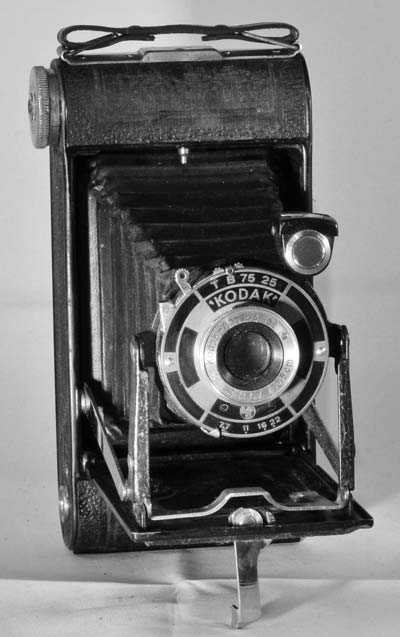Kodak Junior 620 (Early Model)
Specification

| Manufacturer | : | Kodak |
|---|---|---|
| Produced | : | 1933 |
| Classification | : | Medium Format |
| Body Type | : | Folding Bed |
| Bellows Deployment | : | Self Erecting |
| Construction | : | Metal |
| Film Type | : | 620 |
| Film Width | : | 62mm |
| ImageSize | : | 2¼ x 3¼ in |
| No. of Images | : | 8 |
| Lens Type | : | Kodak Anastigmat |
| Focus Type | : | Variable |
| Focal Length | : | 105mm |
| Focal Range | : | 2.5m - inf. |
| Aperture Type | : | Iris |
| Aperture | : | f/7.7 - f/22 |
| Shutter Type | : | Kodak - Alfred Gauthier, Calmbach |
| Shutter Speeds | : | T,B,1/75, 1/25 sec |
| Size Closed (w x h x d) | : | 80 x 155 x 36 mm |
| Size Open (w x h x d) | : | 80 x 155 x 122 mm |
| Weight | : | 468g |
Art Deco Credentials
![]()
![]()
![]()
![]()
Significant: Pronounced and self evident
- Produced during the main Art Deco period.
- Geometric black and chrome faceplate design.
- Chrome struts.
- Line embossed body covering.
- Covering embossed with 'Kodak' on front.
- Covering embossed with 'Junior 620' on back
- Concentric etched circles on film advance.
- Chrome film winder.
- Chrome base plate lock.
- Chromed table stand.
Description
The Kodak Junior 620 was introduced in 1933 and was discontinued in 1939. It is a self-erecting folding rollfilm camera. There is a press plate under the lens to release the strut mechanism to fold the bellows into the body. There are many variations of this camera with a variety of shutters and lenses, the one shown here is one of the early ones. However, in 1937 it was redesigned with a body shutter release. Some 1937 models had chromium plated side panels.
This model has 2 shutter speeds as well as T and B. Socket for table release is provided. It has a fixed f/7.7 lens. The focus range is 2.5m to infinity.
A small swivelling brilliant finder is connected to the shutter housing. There are two tripod mounts for portrait and landscape mode. There is no cover for the red window.
How to Use
This camera takes 620 film which is still available from selected photographic outlets. Although the actual film is the same as 120 film, the spools are different. The 620 spools are slightly shorter and have a smaller diameter. Do not use 120 film in this camera because it will jam and may snap. It is possible to cut down a spool of 120 film to fit or to re-spool some 120 film onto 620 spools in a darkroom or changing bag.
It is advisable to cover the red window except when winding film in low light.
As the shutter speed is low, it is advisable to use a tripod or hold it against a wall or other solid object to get shake-free images. For quick snapshots, hold it firmly against your body.
I suggest you use ISO 100/125 film
The table shows how this camera will perform using ISO 100/125 film. It is based on the 'Sunny 16' rule. Modern film is so forgiving and will produce acceptable results even when overexposed by 2 or 3 stops or underexposed by 1 stop.
The tables assume that the sun is at least 30 degrees above the horizon - that's 10am - 5pm on a summers day (May-August) in the UK.
Remember that the exposure guide in the manual may not be helpful as it is based on the use of old film with a low ISO value.
Using ISO 100/125 film
| Weather Conditions | Shadow Detail | Shutter Speed (s) | ||
|---|---|---|---|---|
| 1/50 | 1/75 | |||
 Sunny SunnySnow/Sand | Dark with sharp edges | - | f/22 | |
 Sunny Sunny | Distinct | f/22 | f/16 | |
 Slight Overcast Slight Overcast | Soft around edges | f/16 | f/11 | |
 Overcast Overcast | Barely visible | f/11 | f/7.7 | |
 Heavy Overcast Heavy Overcast | None | f/7.7 | - | |
 Open Shade Open Shade/Sunset | None | - | - | |